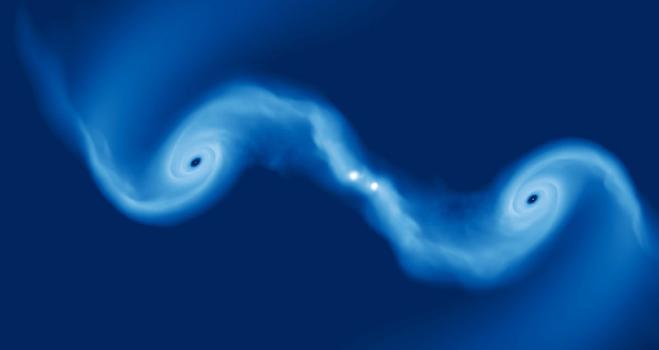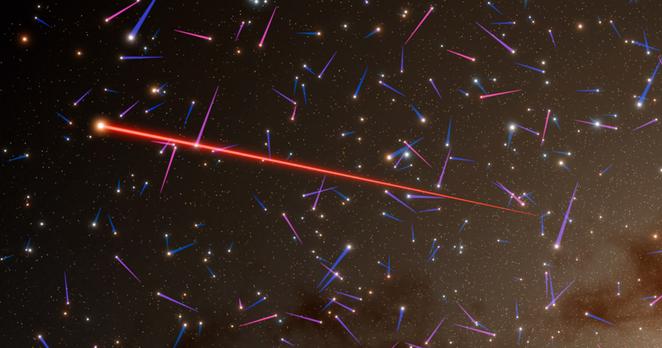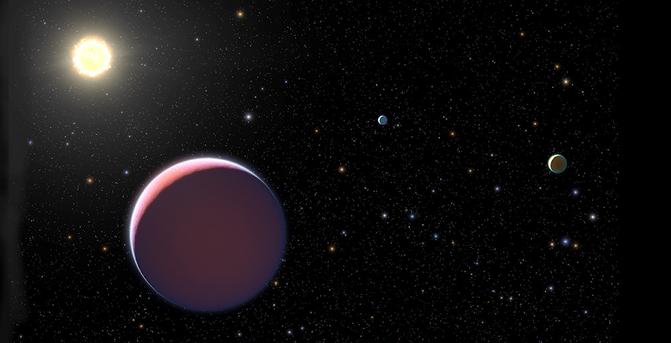Keine Ausgestoßenen: Viele ohne Stern durchs All treibende Planeten könnten anders entstanden sein als gedacht. #Planeten #Exoplanet #Sterne #Astronomie #Rogueplanets
https://www.scinexx.de/news/kosmos/neuer-bildungsweg-fuer-einzelgaenger-planeten/

Keine Ausgestoßenen: Viele ohne Stern durchs All treibende Planeten könnten anders entstanden sein als gedacht. #Planeten #Exoplanet #Sterne #Astronomie #Rogueplanets
https://www.scinexx.de/news/kosmos/neuer-bildungsweg-fuer-einzelgaenger-planeten/

The JWST Weather Report from the Isolated #Exoplanet Analog SIMP 0136+0933 - Pressure-dependent Variability Driven by Multiple Mechanisms: https://iopscience.iop.org/article/10.3847/2041-8213/ad9eaf -> NASA’s Webb Exposes Complex Atmosphere of Starless Super-Jupiter: https://science.nasa.gov/missions/webb/nasas-webb-exposes-complex-atmosphere-of-starless-super-jupiter/
Later today, the first commercial launch of an #Ariane6 rocket is planned, after the maiden flight in July 2024 that was mostly successful. Ariane 6 had been the backup launcher for #Euclid for many years.
Originally and for many years, Euclid was slated to launch on a Russian #Soyuz from French Guyana, which changed following the invasion of Ukraine and the subsequent stop of collaboration of #ESA with Roskosmos, the company behind Soyuz.
After this, Ariane 6 became the primary launcher on launch slot 4 or 5, but given that Euclid was almost ready for launch already in 2022, alternatives were looked into, and in the end Euclid successfully launched with a US company on 1 July 2023.
So we've been following #Ariane6's development for a while. All the best for this launch .
Next #ESA #astronomy mission to be launched with Arianne 6 is the #exoplanet satellite #PLATO, towards the end of 2026.
All about today's launch: https://www.esa.int/Enabling_Support/Space_Transportation/Ariane
Highly reflective white clouds on the western dayside of an exo-Neptune: https://arxiv.org/abs/2501.14016 -> JWST provides insights into rare ultra-hot Neptune LTT 9779 b / Today's forecast - partially cloudy skies on an "ultra-hot Neptune": https://www.physics.ox.ac.uk/news/jwst-provides-insights-rare-ultra-hot-neptune-ltt-9779-b / https://nouvelles.umontreal.ca/en/article/2025/02/25/today-s-forecast-partially-cloudy-skies-on-an-ultra-hot-neptune/ #exoplanet

Weltraumforschung: Astronomen in der Schweiz entdecken neuen Exoplaneten
Ein internationales Forscherteam an der Universität Genf hat einen neuen Exoplaneten entdeckt - also einen Planeten außerhalb unseres Sonnensystems. Der Planet ist rund 19 Lichtjahre von der Erde entfernt. Von P. Verne.
Extrasolarer Gasriese hat dreistöckige Winde. Erste 3D-Kartierung einer Exoplaneten-Gashülle enthüllt einzigartiges Wettermuster. #Exoplanet #Gasriese #Atmosphaere #Astronomie #Planet #WASP121b
https://www.scinexx.de/news/kosmos/extrasolarer-gasriese-hat-dreistoeckige-winde/

Vertical structure of an exoplanet’s atmospheric jet stream / Titanium chemistry of WASP-121 b with ESPRESSO in 4-UT mode: https://www.eso.org/public/archives/releases/sciencepapers/eso2504/eso2504a.pdf / https://www.eso.org/public/archives/releases/sciencepapers/eso2504/eso2504b.pdf -> First 3D observations of an #exoplanet’s atmosphere reveal a unique climate: https://www.eso.org/public/news/eso2504/ -> https://scicomm.xyz/@esoastronomy@astrodon.social/114025738468042057
Lebensfreundliche Supererde um nahe Sonne. 20 Lichtjahre entfernter Exoplanet kreist in der habitablen Zone seines sonnenähnlichen Sterns. #Exoplanet #Supererde #HD20794d #Planet #Astronomie #habitableZone
https://www.scinexx.de/news/kosmos/lebensfreundliche-supererde-um-nahe-sonne-entdeckt/

Erster Schnellläufer-Stern mit Planet entdeckt. Duo aus Zwergstern und Exoplanet ist schnellstes je beobachtetes Planetensystem. #Exoplanet #Stern #Schnelllaeuferstern #Astronomie
https://www.scinexx.de/news/kosmos/erster-schnelllaeufer-stern-mit-planet-entdeckt/

A Candidate High-velocity Exoplanet System in the Galactic Bulge: https://iopscience.iop.org/article/10.3847/1538-3881/ad9b0f/meta -> NASA Scientists Spot Candidate for Speediest #Exoplanet System: https://www.nasa.gov/universe/nasa-scientists-spot-candidate-for-speediest-exoplanet-system
The Roasting Marshmallows Program with IGRINS on Gemini South - WASP-121 b has Superstellar C/O and Refractory-to-volatile Ratios: https://iopscience.iop.org/article/10.3847/1538-3881/ad8574 -> IGRINS on Gemini South Detects Surprising Signatures in Dynamic Atmosphere of #Exoplanet WASP-121b: https://noirlab.edu/public/blog/wasp-121b/ - chemical clues revealed in atmosphere of ultra-hot Jupiter challenge astronomers’ understanding of how ‘roasting marshmallows’ form.
#DLR:
"
Mission PLATO startet Ende 2026 mit Ariane-6-Trägerrakete
"
".. PLATO wird ab Ende 2026 mit 26 Kameras nach erdähnlichen Planeten an über 200.000 Sternen in der Milchstraße suchen
DLR leitet das Nutzlastkonsortium von PLATO und liefert Auslese-Elektronik und Elektronik zur Datenverarbeitung .."
30.1.2025

Extreme Winde auf #Exoplanet „WASP-127b“: Ein internationales Team unter Leitung unseres Instituts für #Astrophysik und #Geophysik hat Winde mit Überschallgeschwindigkeiten von bis zu 33.000 km/h gemessen. Die Forschung wurde am Very Large Telescope der Europäischen Südsternwarte (@esoastronomy) durchgeführt. Die Ergebnisse helfen, die Atmosphärendynamik ferner #Planeten besser zu verstehen: https://s.gwdg.de/rEafaZ; https://doi.org/n3g2
Exoplanet hat schnellste je detektierte Überschallwinde: Astronomen entdecken einen 33.000 Stundenkilometer schnellen Jetstream auf dem Gasriesen WASP-127b. #WASP127b #Ueberschallwind #exoplanet #Astronomie
https://www.scinexx.de/news/kosmos/exoplanet-hat-rekordschnelle-ueberschallwinde/

[Atmosphere, atmosphere ... ] 33,000 km/h, i.e. 9 km/sec! This is the speed of the #winds in the jet stream that encircles the equator of #exoplanet WASP-127b, a gas giant located some 520 light-years from Earth. Molecules of water vapor and carbon monoxide were also detected within this planetary #atmosphere.
The extreme meteorological conditions prevailing on the surface of WASP-127b were deduced from measurements made using the CRIRES+ instrument installed on the Very Large Telescope (VLT) of the @esoastronomy (ESO).
When Worlds (probably) Collide - An #exoplanet collision remnant observed around ASASSN-21qj: https://agu.confex.com/agu/agu24/meetingapp.cgi/Paper/1546283 -> Telescopes Catch the Aftermath of an Energetic Planetary Collision: https://eos.org/articles/telescopes-catch-the-aftermath-of-an-energetic-planetary-collision - a planetary collision 1,800 light-years away birthed a body that has cooled in unexpected ways.
Vierter „Zuckerwatte“-Planet überrascht Astronomen. Gleich vier "zu leichte" Exoplaneten um einen Stern sind mit gängigen Modellen schwer erklärbar. #Zuckerwatteplanet #Exoplanet #Kepler51 #Astronomie #Planeten
https://www.scinexx.de/news/kosmos/vierter-zuckerwatte-planet-gibt-raetsel-auf/

#Astronomy nerds, particularly #exoplanetology nerds: Would it be possible to distinguish a double #exoplanet from a single one using current detection techniques? Desperate writer with arts degree needs to know. Please help. Thanks so much in advance!
JWST/NIRCam 4–5 μm Imaging of the Giant Planet AF Lep b: https://iopscience.iop.org/article/10.3847/2041-8213/ad736a -> UT Astronomers Race To Capture Image of #Exoplanet Near Star: https://news.utexas.edu/2024/10/09/ut-astronomers-race-to-capture-image-of-exoplanet-near-star/
JWST/NIRISS Reveals the Water-rich "Steam World" Atmosphere of GJ 9827 d: https://iopscience.iop.org/article/10.3847/2041-8213/ad6f00 -> Astronomers probe a “steam world”: https://nouvelles.umontreal.ca/en/article/2024/10/04/astronomers-probe-a-steam-world/ - scientists explore the exoplanet GJ 9827 d and find a significant amount of water vapor in its atmosphere. #exoplanet